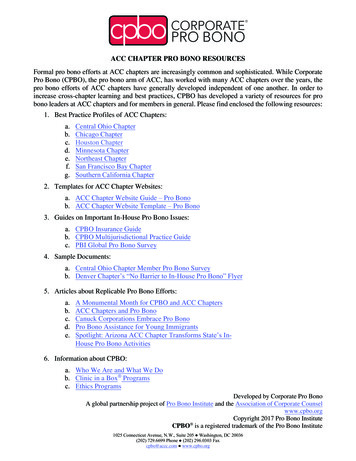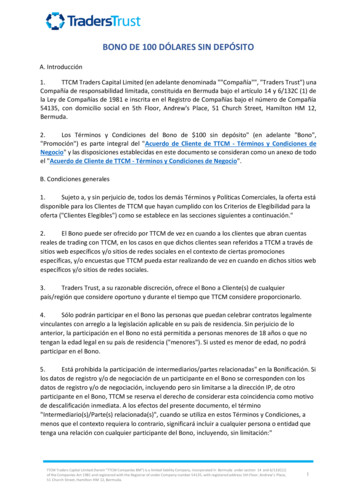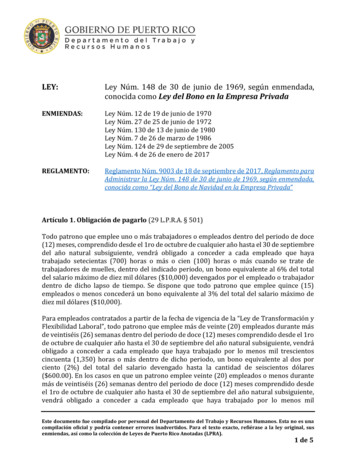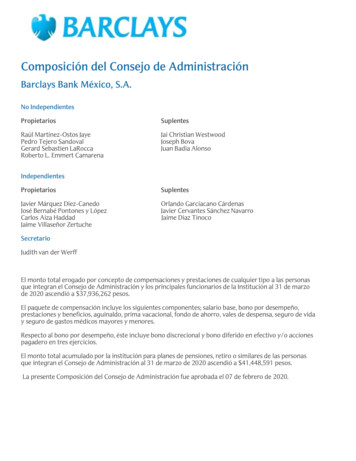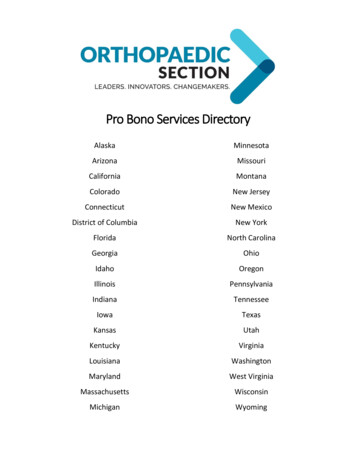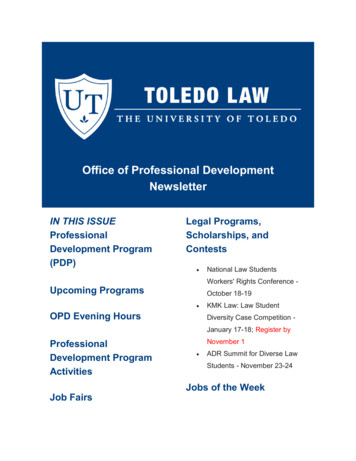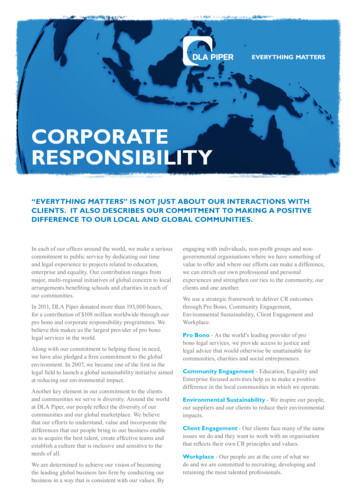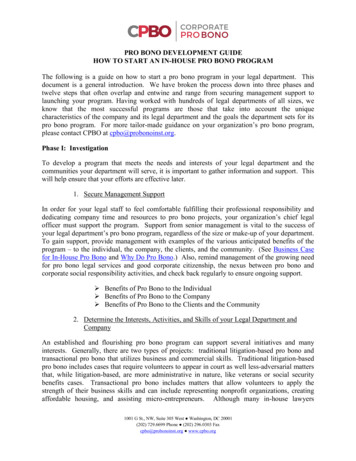
Transcription
PRO BONO DEVELOPMENT GUIDEHOW TO START AN IN-HOUSE PRO BONO PROGRAMThe following is a guide on how to start a pro bono program in your legal department. Thisdocument is a general introduction. We have broken the process down into three phases andtwelve steps that often overlap and entwine and range from securing management support tolaunching your program. Having worked with hundreds of legal departments of all sizes, weknow that the most successful programs are those that take into account the uniquecharacteristics of the company and its legal department and the goals the department sets for itspro bono program. For more tailor-made guidance on your organization’s pro bono program,please contact CPBO at cpbo@probonoinst.org.Phase I: InvestigationTo develop a program that meets the needs and interests of your legal department and thecommunities your department will serve, it is important to gather information and support. Thiswill help ensure that your efforts are effective later.1. Secure Management SupportIn order for your legal staff to feel comfortable fulfilling their professional responsibility anddedicating company time and resources to pro bono projects, your organization’s chief legalofficer must support the program. Support from senior management is vital to the success ofyour legal department’s pro bono program, regardless of the size or make-up of your department.To gain support, provide management with examples of the various anticipated benefits of theprogram – to the individual, the company, the clients, and the community. (See Business Casefor In-House Pro Bono and Why Do Pro Bono.) Also, remind management of the growing needfor pro bono legal services and good corporate citizenship, the nexus between pro bono andcorporate social responsibility activities, and check back regularly to ensure ongoing support. Benefits of Pro Bono to the Individual Benefits of Pro Bono to the Company Benefits of Pro Bono to the Clients and the Community2. Determine the Interests, Activities, and Skills of your Legal Department andCompanyAn established and flourishing pro bono program can support several initiatives and manyinterests. Generally, there are two types of projects: traditional litigation-based pro bono andtransactional pro bono that utilizes business and commercial skills. Traditional litigation-basedpro bono includes cases that require volunteers to appear in court as well less-adversarial mattersthat, while litigation-based, are more administrative in nature, like veterans or social securitybenefits cases. Transactional pro bono includes matters that allow volunteers to apply thestrength of their business skills and can include representing nonprofit organizations, creatingaffordable housing, and assisting micro-entrepreneurs. Although many in-house lawyers1001 G St., NW, Suite 305 West Washington, DC 20001(202) 729.6699 Phone (202) 296.0303 Faxcpbo@probonoinst.org www.cpbo.org
2consider the chance to handle pro bono litigation matters a welcome change of pace from theirdaily practice, others prefer opportunities that allow them to apply the skills they use for theiremployer.Legal DepartmentThe best way to determine the interests of your legal staff is to conduct a survey that asksmembers of your legal department what legal pro bono work are they currently doing, what typeof work they would be interested in doing, and what the perceived impediments are to providinglegal pro bono work. You may be surprised at what is already in place and the reasons whysome colleagues are hesitant to participate. (Request Interest Survey) If you are aware of certaininterests of your legal department, company or management, you may tailor your survey to focuson those specific options. What are People Doing Now? What are People Interested in Doing? What are the Perceived Impediments to Doing Pro Bono?The CompanyAlso, research your organization’s corporate social responsibility (CSR) or foundation goals andefforts. To the extent you can coordinate efforts (see Intersection of CSR and Pro Bono), youwill not only be more likely to obtain management support, but once you launch your pro bonoprogram, it may be more impactful on the intended beneficiaries and create ancillary benefits toyour organization such as an increased sense of community across departments. What are the CSR and Foundation Goals and Efforts? Are There Opportunities to Coordinate?3. Examine the Needs of the Community and Identify Opportunities and PartnersBefore your legal department proceeds any further, familiarize yourself with the unmet legalneeds in the communities in which your legal department operates. Learn about local andnational pro bono providers (legal services organizations that screen and place pro bono cases,law firms that have strong pro bono programs, community development groups and nonprofitorganizations) and the types of matters for which they most desperately need volunteers. Thesewill be the most abundantly available matters and those through which your legal departmentmay have the greatest impact. In addition, consider what other law departments in your area aredoing (see CPBO Best Practice Profiles) and contact your local ACC Chapters to determine whatpro bono activities they may have planned.Inquire specifically about transactional pro bono opportunities, discreet and time-limited probono projects, as well as other pro bono projects that address issues or concerns your colleaguesraised in response to the pro bono survey. Use this time to assess the landscape and obtainanswers to your questions. Corporate Pro Bono and the Pro Bono Institute can also help you tolocate legal needs studies and identify key public interest organizations and community groups.1001 G St., NW, Suite 305 West Washington, DC 20001(202) 729.6699 Phone (202) 296.0303 Faxcpbo@probonoinst.org www.cpbo.org
3 Legal Services ProvidersLaw FirmsCommunity Development GroupsOther Nonprofit OrganizationsIn-House Law DepartmentsACC ChaptersWe also recommend that you speak with your CSR or foundation colleagues about theorganizations they support and their needs. Again, investigate whether there are opportunitiesfor your legal department to provide legal assistance to complement programs and servicesalready supported by your company (keeping in mind potential conflict issues) or researchopportunities that relate to the same focus areas as your company’s philanthropic efforts.4. Clarify the Scope and Goals of Your ProgramBefore delving too far, clarify the vision your department has for its pro bono initiatives. Thiswill inform the choices you make as you create and develop your program.Nature and Scope of EngagementsOne area for you to focus is the nature and scope of engagements your department’s programwill support. Generally, there are two types of programs: cafeteria style programs and signaturepro bono programs. A cafeteria style program empowers members of the legal department toprovide legal services to individuals or organizations of their choosing. Departments mayimpose certain limits, such as developing a list of approved pro bono providers, but within thoselimits legal staff has the opportunity to pursue a wide range of pro bono projects. Alternatively,a signature pro bono program allows a department to focus its pro bono activities on one or morespecific areas of the law or population, such as education or veterans, increasing thedepartment’s ability to impact a specific legal need. (See Signature Projects: A Pro Bono Modelof Focus and Commitment.) Many departments have adopted a hybrid model, offering legal staffthe opportunity to pursue their individual passions, while sponsoring several signature initiativesthat the department as a whole supports and promotes. Cafeteria Style Program Signature Pro Bono Program Hybrid Pro Bono ProgramBreadth of the ProgramFor departments that have offices around the world, deciding whether your program will initiallybe available to all legal staff or will start where the majority of your lawyers are located is animportant step. Many larger legal departments launch their programs in one or two of theirbigger offices and then expand to other offices as the programs mature. However, somedepartments have launched global programs that engage the majority of offices from the start,regardless of location.1001 G St., NW, Suite 305 West Washington, DC 20001(202) 729.6699 Phone (202) 296.0303 Faxcpbo@probonoinst.org www.cpbo.org
4 Local Program National Program Global ProgramIn addition, all departments (regardless of size) should determine whether their pro bonoprogram will be limited to attorney volunteers or engage the entire legal department, includingparalegals, contract and compliance specialists, and other support and professional staff. Mostlegal departments engage all legal staff in the administration and implementation of thedepartments’ efforts. By doing so, departments are able to increase capacity, promoteteambuilding, and add additional skills to their programs. Engage Paralegals, Administrative Professionals, and Other StaffGoals of the ProgramFinally, you should consider the objectives of your pro bono program. For most departments, anumber of reasons lead them to formalize their pro bono efforts. As a result, their programs haveseveral goals. They may include addressing a pressing legal need in the community, unitinglegal staff and boosting morale, providing creative opportunities to develop new skills or workcross-functionally, and offering opportunities to efficiently satisfy professional and ethicalobligations. Identifying all of the goals of your program will inform the structure and initiativesyour department puts in place. Impact Community NeedUnite the DepartmentBoost Morale and Increase EngagementWork Cross-Functionally / Enhance SkillsSatisfy Professional and Ethical ObligationsPhase II: Building InfrastructureDeveloping a formal structure for your pro bono program will allow you and your colleagues tofocus more on the substantive pro bono work once the program is launched. In addition, a solidstructure helps ensure a consistent level of quality in the projects undertaken and reducesvolunteer confusion and frustration.To create the right structure for your pro bono program, we recommend that you examine avariety of factors, including department size, location, and corporate culture. We alsorecommend that you consider some of the ethical and liability issues involved in pro bono work(malpractice insurance, multijurisdictional practice, and conflicts of interest).1001 G St., NW, Suite 305 West Washington, DC 20001(202) 729.6699 Phone (202) 296.0303 Faxcpbo@probonoinst.org www.cpbo.org
55. Develop a Structure to Achieve GoalsPro Bono Coordinator and CommitteeThe first question you may have is who is going to create and maintain the structure to managethe pro bono program. Regardless of the size of your department or the type of the program youcreate, designating at least one person to direct and coordinate the management of the pro bonoprogram is essential. This person works to establish the pro bono program structure, sometimeswith the assistance of a pro bono committee. He or she is the primary point of contact for the probono program and generally administers the program. (Request Sample Job Description)In addition, some legal departments form a pro bono committee or task force. These workinggroups are usually comprised of attorney and non-attorney staff, and often have representationfrom each office or other subgroup that the department may use for organization. Especially inlarger departments, the committee can serve as a valuable resource and assist the pro bono chairor coordinator in the administration of the program, which may include tasks such as managing alisting of pro bono opportunities, disseminating information, overseeing logistical aspects of theprogram, communicating with partners, and planning recognition events. (Request Sample JobResponsibilities)Serving in these positions can be a great way for members of the legal department to get moreinvolved and work with others with whom they would not typically interact. Designate a Coordinator(s) Form a Committee/Working GroupProfessional Pro Bono ManagementWhile the vast majority of legal departments have volunteer coordinators or volunteer pro bonocommittees who run their programs, a small number of departments with more mature pro bonoprograms have engaged dedicated pro bono professionals to manage their programs. Thesededicated pro bono professionals fall into many different molds, including full-time pro bonomanager, attorney with both pro bono and business responsibilities, part-time independentcontractor, and short-term legal fellow. Dedicated pro bono professionals may be tasked withstrategic responsibilities (such as developing a signature project or implementing long-termgoals), with operational responsibilities that relieve volunteers of some of the day-to-dayadministration of the program, or both. (Request Paper on Professionalization of In-House ProBono)Work PlanThe next question you may have is how you will create the structure to manage the pro bonoprogram. In addition to this guide, we have created a sample work plan that covers many of theitems addressed herein and outlines tasks to consider as you build your pro bono program.(Request Sample Work Plan) We encourage you to use this work plan as another guide and totailor it as appropriate for your department and its pro bono program.1001 G St., NW, Suite 305 West Washington, DC 20001(202) 729.6699 Phone (202) 296.0303 Faxcpbo@probonoinst.org www.cpbo.org
6IntranetTo help manage and organize their pro bono efforts, some departments add pro bono focusedpages to existing intranet sites or create a pro bono intranet to house information about theprogram and keep track of the program’s progress. An intranet site is a useful place to post probono opportunities, policies, form documents, training materials, and other relevant information.Creating a central location where legal staff can go to find answers to questions helps to easeadministration of the pro bono program and provides a place to share success stories about yourdepartment’s efforts.BudgetTo support your work, you may need to determine the funds available to your in-house pro bonoprogram. It does not take a lot of money to run a program, but it is not for free and, dependingupon what you have in mind, there could be more expenses than you have considered. (SeePlanning Your In-House Pro Bono Budget.)6. Draft DocumentsPolicy and ProceduresA pro bono policy can be a very effective tool in defining expectations and setting goals for yourprogram. Whether or not your department chooses to adopt a policy depends on your objectivesand departmental culture. Some departments, for instance, see no need for a pro bono policybecause they view pro bono as falling under the company’s general policy on volunteerism.Others have carefully outlined each element of their department’s pro bono program in a separatepolicy.In any case, volunteers will have questions and it is useful to put the answers to these questionsin writing, whether as guidelines, an informal frequently asked questions document, or a moreformal pro bono policy. (See Form FAQs and Sample Policies.) This will provide clarity anddirection to interested volunteers and legal staff. (See Pro Bono Policy Questions to Ask.) FAQs Pro Bono Policy Pro Bono GuidelinesSample Matter FormsThere may be other documents that you will need for the administration of your program. Forinstance, if members of the legal departments must request approval of projects, you may want aform for them to use in making such a request. (Request Sample Intake Form) Then, ifapproved, you may need an engagement letter for direct representation matters. (Request FormEngagement Letter) When the matter is over, we advise sending a termination letter to the client.1001 G St., NW, Suite 305 West Washington, DC 20001(202) 729.6699 Phone (202) 296.0303 Faxcpbo@probonoinst.org www.cpbo.org
7(Request Form Termination Letter) You also may want to submit a matter closing form to thepro bono program’s leadership. (Request Sample Matter Closing Form) Intake FormEngagement LetterTermination LetterMatter Closing Form7. Address Ethical and Liability IssuesThere are several ethical and liability issues involved in pro bono work that a department mustconsider when structuring its program.Right to Practice RestrictionsMany in-house lawyers are not admitted to practice law in the jurisdictions where they work.Most states permit these lawyers to work for their employers, often through a registration orauthorization process, but restrict the ability of these lawyers to provide pro bono services tounderserved communities. Determine where the attorneys in your legal department are licensedand review the applicable state practice rules to make sure your program is in compliance withthose rules. For a guide of important information regarding multi-jurisdictional practice issues inthe pro bono context, see Multijurisdictional Practice: In-House Pro Bono. Chart Where Members of Your Department are Licensed Review Applicable State Rules Consider Impact on Project SelectionMalpractice InsuranceIn-house attorneys providing pro bono work are not always covered under their companies’general indemnification policies or their insurance policies. Luckily, obtaining such insurancecoverage is relatively easy and affordable, whether through the company’s provider or throughanother organization that offers insurance coverage for pro bono work. In addition, many legalservices providers offer insurance coverage to their pro bono volunteers, so affiliation with suchgroups will often resolve this issue. For a complete discussion on the range of availableinsurance options, please refer to Professional Liability Insurance for In-House Pro Bono. Company’s Indemnification PolicyPro Bono Insurance PolicySelf-InsureLegal Services Provider Insurance PolicyConflicts of InterestGenerally, there are two types of conflicts of interest that legal departments should considerwhen forming a pro bono program: direct conflicts of interest and positional or businessconflicts.1001 G St., NW, Suite 305 West Washington, DC 20001(202) 729.6699 Phone (202) 296.0303 Faxcpbo@probonoinst.org www.cpbo.org
8Unlike law firms, which represent numerous clients with potentially adverse interests, in-housedepartments usually do not need complex clearing procedures to monitor direct conflicts.However, when it comes to pro bono work, direct conflicts may arise. This risk does not have topose an intractable problem. With clear intake tracking procedures for pro bono matters and agood measure of common sense, your legal department should be able to avoid direct conflicts.To prevent positional or business conflicts, it may be advisable for some legal departments toavoid certain types of pro bono matters. For example, banking institutions may decide toprohibit volunteers from handling certain consumer-law-related issues. Some legal departmentshave pro bono policies that clearly spell out their procedure for clearing and avoiding conflicts.Other departments leave it to the personal judgment of each attorney. The best approach foryour department will depend on your company’s line of business, culture, and available pro bonoopportunities. (Request Sample Conflicts Provisions) Direct Conflicts of Interest Business or Positional Conflicts of Interest8. Secure Partnership RelationshipWhen you are ready, your legal department may want to explore establishing a pro bonopartnership with one or more of your law firm affiliates or legal services providers for a varietyof strategic reasons. First, law firms and legal services providers can train your attorneys in therelevant subject matter (family law, housing law, etc.), and also serve as a resource whencomplex issues arise. Second, your legal department may not have the resources to administer alarge pro bono program, whereas, law firms and legal services providers are often able to providethe administrative support for pro bono projects, including the screening of potential cases.Third, legal services providers may also provide malpractice insurance.You also might consider collaborating with other legal departments or with your local ACCChapter, which can increase the number of volunteers available. It also spreads outadministrative responsibilities over a larger group. Most importantly, you may have a greaterimpact on the issues you are trying to address in your community. Law Firm Partner Legal Services Provider Partner Collaboration with other Legal DepartmentsWhen forming a pro bono partnership, whether with a legal services provider, law firm, oranother legal department, you should clarify and understand the expectations of all partiesinvolved. Some departments have drafted memorandum to define the relationship. Otherdepartments have taken a less formal approach, but require partner organizations to maintainregular communication with the departments’ pro bono coordinator or committee. Ensuring thesuccess of a pro bono partnership will require care and effort. (Request Sample Memorandum ofUnderstanding) Clarify Expectations1001 G St., NW, Suite 305 West Washington, DC 20001(202) 729.6699 Phone (202) 296.0303 Faxcpbo@probonoinst.org www.cpbo.org
9 Communicate Regularly Draft Partnership Memorandum of UnderstandingPhase III:Implementation and Launch9. Confirm Pro Bono Projects and EngagementsSelecting projects for your legal department can be challenging. There are a variety of availableopportunities that range dramatically in terms of clients, area of law, type of case, and level oftime commitment. Selecting among them involves balancing the interests and concerns of yourcompany, department, and legal staff, with the needs of the communities in which you work, andthe opportunities available. This can be a daunting task. The good news is that pro bono is notstatic and that programs can and should evolve over time.Finite and Manageable Pro BonoOne common concern for in-house pro bono programs, particularly start up programs, is findingmatters that fit the work demands of legal departments. Many in-house lawyers haveunpredictable schedules which makes it desirable for their departments to identify and offer legalstaff pro bono matters that are finite or reliably scheduled. Fortunately, these types ofopportunities are available or can be put in place and range from telephone hotlines to briefadvice clinics, like CPBO’s Clinic in a Box program, to community legal education seminars.There also are many meaningful desktop pro bono projects that do not require travel and areideal for legal staff in law departments located in areas not easily accessible to most pro bonoopportunities or clients. Legal HotlinesPro Bono ClinicsCommunity Legal Education SeminarsDesktop Pro BonoLonger Term EngagementsWhile finite and time manageable pro bono engagements are important, you also should consideridentifying longer term pro bono engagements. Just as there are many finite pro bonoopportunities, there is a wealth of longer term projects that are ideal for legal departments,regardless of size. This includes traditional litigation based pro bono projects where volunteersprovide direct representation to individual clients. It also includes policy advocacy, offeringongoing advice and counsel to nonprofit organizations or small business owners, and legalresearch projects. As your volunteers become more experienced and your program matures,providing legal staff longer term projects may become a significant goal. Policy Advocacy Direct Representation General Counsel Services1001 G St., NW, Suite 305 West Washington, DC 20001(202) 729.6699 Phone (202) 296.0303 Faxcpbo@probonoinst.org www.cpbo.org
10Training and SupportTo ensure that your volunteers are comfortable and well prepared to work on a pro bonoengagement, you should offer training materials and programs. Most legal services providersand law firm pro bono partners can organize and host training opportunities for your department.Another way to provide support to your volunteers is to allow them to work in teams within thedepartment. This also is a great way to involve non-lawyers in your pro bono matters. Pro Bono Partner Organizations Pro Bono Teaming10. Engage Your Legal DepartmentWhether through your department’s intranet, regular emails, an e-newsletter, award ceremoniesat department meetings, videos, or an annual report, your program should develop acommunications strategy to keep legal staff informed and engaged. There is no need to recreatethe wheel; many legal departments utilize existing communications vehicles. The key is to usethe most effective tools at your disposal and to integrate pro bono into the culture of your legaldepartment, including working with your company’s communication department to publicize thesuccesses of your program, internally and externally.You should not overlook the personal touch when engaging volunteers. Many in-house attorneysand legal staff may be nervous about providing pro bono services. Hearing stories from thosewho volunteer will inspire others and will confirm that it is possible – legal staff can use theirunique skills to make a difference. IntranetEmailsNewslettersAwardsVideosAnnual ReportPersonal Appeals11. Measure the Impact of Your Pro Bono ProgramIt is important that departments measure the success of their programs. Metrics is the practice ofmeasuring and evaluating effectiveness, and CPBO advocates the application of this wellestablished business principle to in-house pro bono work. We recommend measuring the successof your program in three areas: core performance and productivity, benefits to the clients andcommunity, and benefits to the company. (Request Metrics Toolkit) We also encouragecompanies to join the Corporate Pro Bono Challenge initiative, which was designed by CPBOto identify, benchmark, and communicate a company’s commitment to pro bono service. (SeeChallenge FAQs and List of Challenge Signatories.) Core Performance1001 G St., NW, Suite 305 West Washington, DC 20001(202) 729.6699 Phone (202) 296.0303 Faxcpbo@probonoinst.org www.cpbo.org
11 Social Good Benefits Business Benefits Corporate Pro Bono Challenge InitiativeThere are a number of tools you can use to measure the success of your program, includingrequesting information from volunteers through online reporting systems, surveys, closing matterforms, and self-evaluations or performance reviews. (Request Sample Matter Outcome Form)We also encourage departments to revise existing systems to include pro bono to make trackingpro bono easier. Matter Management SystemClosing FormsSurveysSelf-Evaluation Reviews12. Launching Your ProgramMany departments elect to host kick-off events, such as a pro bono lunch or reception, at whichthe general counsel offers his or her endorsement of the newly launched program. At the event,you can introduce future volunteers to the pro bono committee members, discuss the goals of theprogram, and explain to attorneys and other legal department staff the procedure for taking onpro bono projects. You may also invite local law firms and legal services providers to givepresentations regarding available pro bono opportunities.To provide momentum, your launch should include clearly defined next steps for volunteers toensure that they are engaged and to promote involvement. You may decide to announceupcoming training programs or pro bono opportunities or to integrate training into your programlaunch. A few departments have hosted pro bono clinics at the launch of their program. That isone way to generate enthusiasm and, if repeated on an annual or semi-annual basis, maintainprogram momentum. Highlight Management Support for the Program Discuss Goals and Provide Information Encourage Involvement with Next StepsPost Launch: Evaluate and AssessNow that your program is launched, we encourage you to revisit it periodically to reassesses, reevaluate, and, if necessary, restructure. You may discover that your goals for the program havechanged, that it is time to identify new opportunities in the community, create new partnershiprelationships or expand the breadth of pro bono opportunities your company provides. You mayhave new questions and concerns. CPBO offers a range of information, materials, and supportfor departments that are expanding or maturing their pro bono effort.***1001 G St., NW, Suite 305 West Washington, DC 20001(202) 729.6699 Phone (202) 296.0303 Faxcpbo@probonoinst.org www.cpbo.org
12For more information about how CPBO can help, visit our website at www.cpbo.org. Forassistance with starting your organization’s pro bono program, please contact CPBO atcpbo@probonoinst.org.Developed by Corporate Pro BonoA project of Pro Bono Institutewww.cpbo.orgCopyright 2019 Pro Bono InstituteCPBO is a registered trademark of Pro Bono Institute1001 G St., NW, Suite 305 West Washington, DC 20001(202) 729.6699 Phone (202) 296.0303 Faxcpbo@probonoinst.org www.cpbo.org
for pro bono legal services and good corporate citizenshipthe nexus between pro bono and , corporate social responsibility activities, and check back regularly to ensure ongoing support. Benefits of Pro Bono to the Individual Benefits of Pro Bono to the Company Benefits of Pro Bono to the Clients and the Community 2.
